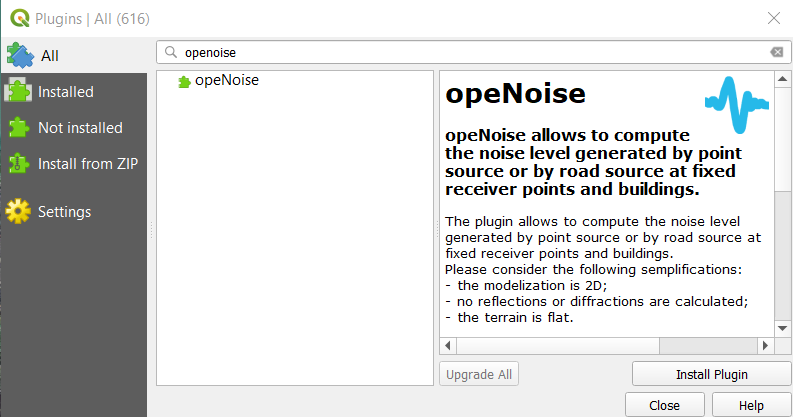Difference between revisions of "Noise Modelling using OpeNoise in QGIS"
| Line 13: | Line 13: | ||
2) Click "Plugins" on the ribbon at the top of the screen, then click "Manage/install plugins" |
2) Click "Plugins" on the ribbon at the top of the screen, then click "Manage/install plugins" |
||
| − | [[File:Qgisribbon.png|frame]] |
+ | [[File:Qgisribbon.png|frame|left|200px]] |
| + | |||
| + | |||
| + | |||
| + | |||
| + | |||
| + | |||
| + | |||
3) Search for opeNoise and click "Install Plugin". The user can access opeNoise by clicking on the "Plugins" option on the ribbon. |
3) Search for opeNoise and click "Install Plugin". The user can access opeNoise by clicking on the "Plugins" option on the ribbon. |
||
| − | [[File:OpeNoisemain.png|frame]] |
+ | [[File:OpeNoisemain.png|frame|thumb|left|200px]] |
Revision as of 12:09, 18 December 2020
Introduction
Purpose
The objective of this tutorial is to help the user visualize the impact of sound and how it propagates from a location. The user will do this using the “Openoise” Plugin in QGIS and create a noise map assessing the exposure to noise in a given area, due to the existence of different sources of noise. For this tutorial, the noise to be modelled is the impact of formula 1 race cars at Baku City Circuit, Azerbaijan.
Accessing opeNoise Plugin in QGIS
To complete this tutorial the user will need to install the opeNoise plugin by :
1) Install *QGIS 3.10 and open QGIS Desktop
2) Click "Plugins" on the ribbon at the top of the screen, then click "Manage/install plugins"
3) Search for opeNoise and click "Install Plugin". The user can access opeNoise by clicking on the "Plugins" option on the ribbon.
